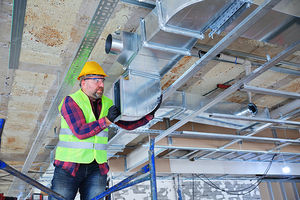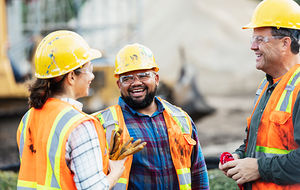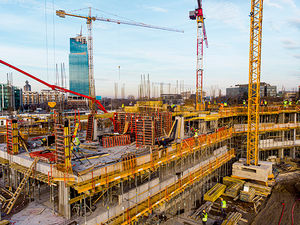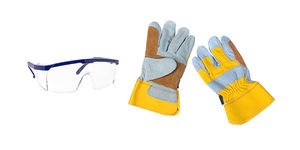 There are roughly 150,000 construction site accidents in the US each year according to the Bureau of Labor Statistics. This statistic shows why understanding job hazards and following proper safety protocols is important on jobsites. Following workplace safety guidelines and being aware of risks can help prevent accidents while visiting any construction work zone. Each jobsite is unique and presents its own potential safety hazards. Unlike controlled environments like an office or school, jobsite conditions are constantly changing, and new hazards and safety concerns pop up as construction progresses. Different crews of subcontractors come and go to complete various trades, weather conditions change the environment, and sometimes delays cause a breakdown in communication; all these variables impact the working conditions and safety of a jobsite.
There are roughly 150,000 construction site accidents in the US each year according to the Bureau of Labor Statistics. This statistic shows why understanding job hazards and following proper safety protocols is important on jobsites. Following workplace safety guidelines and being aware of risks can help prevent accidents while visiting any construction work zone. Each jobsite is unique and presents its own potential safety hazards. Unlike controlled environments like an office or school, jobsite conditions are constantly changing, and new hazards and safety concerns pop up as construction progresses. Different crews of subcontractors come and go to complete various trades, weather conditions change the environment, and sometimes delays cause a breakdown in communication; all these variables impact the working conditions and safety of a jobsite.
Common Hazards You Can Encounter
 Construction jobsites can change day to day due to the complexity of projects happening and sheer scale of the location. Over time a jobsite can quickly change around you with hazards popping up all around. Construction workers wear safety gear and are well-trained to manage heavy machinery, materials, and safety hazards. It is important when visiting a jobsite that you read all safety signage, handbooks, guides and instructions provided and listen to the supervisor when they provide their tour information. Some hazards you could encounter are:
Construction jobsites can change day to day due to the complexity of projects happening and sheer scale of the location. Over time a jobsite can quickly change around you with hazards popping up all around. Construction workers wear safety gear and are well-trained to manage heavy machinery, materials, and safety hazards. It is important when visiting a jobsite that you read all safety signage, handbooks, guides and instructions provided and listen to the supervisor when they provide their tour information. Some hazards you could encounter are:
Ground Hazards
Construction sites are not level. You will be around dirt, materials, unprotected edges, trip hazards, holes, and uneven ground. It’s easy to scrape an ankle or trip over items if you are not paying attention to the ground. Open trenches and excavations are especially hazardous on jobsites as they may not be properly marked or barricaded and may not be readily visible if excavated material has been removed.
Overhead Hazards
Work at height happens onsite frequently when building roofs, ramps, and other structures. Areas around scissor and boom lifts are always barricaded with caution or danger tape. Make sure to look up to avoid head injuries or falling items.
Noise Exposure
Depending on the contractors on site and the tools/equipment they might be using, it is important to ensure your hearing is protected with proper ear plugs or safety earmuffs if necessary.
 Ladders and Scaffolding
Ladders and Scaffolding
Ladders and scaffolding should be properly secured. Avoid walking under these structures.
Cones and Tapes
Cones create a barricade around a potential danger and are often paired with caution tape. Caution tape indicates there is a potential hazard and extra awareness should be given to determine what the hazard is before proceeding. Danger tape should never be crossed in any circumstances.
Tools, Forklifts, and Heavy Equipment
The tools and equipment used during construction are usually very powerful, sharp and heavy. They could be electrified or hot, posing possible shock or burn dangers. For instance, arc welding around a construction site creates an additional danger to visitors if they are not wearing proper eye protection. Construction workers are trained to use this equipment with care, so it is important to not touch tools and only go near them with supervision. Forklifts and heavy machinery are extremely dangerous even when used properly. Rollovers, struck-by accidents and caught-in or between accidents are common ways workers and visitors can be injured when in use. Give these vehicles plenty of leeway and avoid walking in high traffic areas.
Sounds and Alerts
Sirens, alerts, bells, horns, and warning signals should be paid attention to when visiting a jobsite. Alarm systems give everyone adequate warning of impending danger and time to safely avoid or evacuate from the work area if an emergency arises.
Dress for Safety
Ensure you are wearing the proper attire to visit a jobsite. Shorts, skirts, dresses, and flowy shirts should never be worn. Long pants and long-sleeve tops can help mitigate the risk of injury from sharp or hot materials. Long hair should be covered or tied up and loose jewelry should be avoided to ensure that neither gets caught in machine parts. Open toed shoes, high heels, or sandals should not be worn to avoid injury.
Personal Protective Equipment (PPE) should be worn when visiting a jobsite especially when construction is in progress. Depending on the job and nature of the risks involved there usually is a requirement to wear certain items of PPE listed below:
 Hard hat
Hard hat- Safety glasses or safety shield
- Safety shoes
- High visibility vest
- Hearing protection
- Gloves
- Fall protection (safety harness, lanyard, anchor, etc...)
Leaving a Jobsite
When leaving a jobsite, it is important to return your visitor badge, PPE, or visitor pass prior to departure. Visitors should always sign out (if there is a sign-out book) or inform a jobsite supervisor they are leaving the jobsite.
